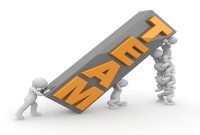- Home
- Business Processes
- Industry Knowledge
- Aerospace Industry
- Automotive Industry
- Banking Domain
- BFSI Industry
- Consumer/ FMCG Industry
- Chemicals Industry
- Engineering & Construction
- Energy Industry
- Education Domain
- Finance Domain
- Hospitality Domain
- Healthcare Industry
- Insurance Domain
- Retail Industry
- Travel and Tourism Domain
- Telecom Industry
- Leadership Skills
- eLearning
- Home
- Leadership
- Career Management
- Bureaucratic Management
Bureaucratic Management
Max Weber gave the theory of Bureaucratic Management in 1915. Bureaucracy is a specific form of organization defined by complexity, division of labor, professional management, and hierarchical management control. Weber's theory has two essential elements - organizational hierarchy and rules-based management. Weber made a distinction between authority and power and advocated that authority must be given to the most competent and qualified people.
Bureaucratic management as one of the schools of classical management emphasizes the need for organizations to function based on professional management and hierarchical management control.
Weber (1864-1920), was a contemporary of Fayol and was one of the major contributors to the management school of thought. He observed that nepotism, which is the hiring of relatives in the organization, based on their relationships with owners and regardless of their professional competence, capabilities, and qualities was prevalent in most organizations. Weber (1915) felt that nepotism was not the right way of running an organization, was grossly unjust, and eventually hindered both the progress of individuals as well as growth or organizations. He, therefore, identified the characteristics of an ideal bureaucracy. According to Weber, bureaucracy represents the most efficient organizational design. Taylor emphasized the separation of planning and doing tasks.
Bureaucracy word is derived from the German word 'bur' and means “office”, referred to organizations that operated on a rational basis. According to Weber, "bureaucracy is a highly structured, formalized, and impersonal organization. In other words, it is a formal organization structure with a set of rules and regulations". Many leaders follow the bureaucratic leadership style.
Advantages of Bureaucracy
Nowadays, the term "bureaucracy" is used to denote excessively complicated administrative procedures with multilayered systems and processes. Clubbed with rigidness in operations with mountains of paperwork, procedures, and rules bureaucratic model is believed to slow down an organization's capacity to achieve stated goals. However, the bureaucratic characteristics of organizations outlined by Weber have certain advantages.
- It helps remove ambiguities and inefficiencies that characterize many organizations.
- Undermine the culture of patronage that he saw in many organizations.
- Competence and creativity thrive within a bureaucracy as bureaucracy demands a higher level of education and self-direction.
- The structure of bureaucracy creates more job security and provides a better work-life balance to the employees.
- In a bureaucracy impersonal relationships are formed, equality is respected and provides everyone an equal opportunity to succeed.
- In a bureaucracy, specific roles and duties are assigned that enable managers to supervise work and facilitates a team-based environment.
- It encourages specialization and promotes problem-solving and cost efficiencies by putting the best people at the best jobs.
Sources of Power
Weber also made a distinction between authority and power. Weber believed that power educes obedience through force or the threat of force which induces individuals to adhere to regulations. According to Max Weber, there are three types of power in an organization:-
- Traditional Power
- Charismatic Power
- Bureaucratic Power or Legal Power
Features of Bureaucracy:
- Division of Labor.
- Formal Hierarchical Structure.
- Selection based on Technical Expertise.
- Management by Rules.
- Written Documents.
- Only Legal Power is Important.
- Formal and Impersonal relations.
Suggested Reading and Resources
Related Links
You May Also Like
-
Administrative Theory by Fayol
The administrative theory of management is focused on principles that could be used by managers to coordinate the internal activities of organizations. The most prominent of the administrative theorists was Henri Fayol. Fayol observed a work stoppage and judged it to be a management failure. He believed that organizational managerial practices are important for driving predictability and efficiency in organizations.
-
Team Foundation in Forming Stage
This is the first stage of team development. This is the stage when the foundation of the team is laid. During the Forming stage, team members have a high dependence on their leader for guidance. Learn the practical strategies you can use during this stage to help your team develop into a highly effective performing team.
-
Maslow's hierarchy of needs is a motivational theory that explains that people are motivated by five basic categories of human needs. These needs are physiological, safety, love and belonging, esteem, and self-actualization. There is a little scientific basis for this concept of a hierarchy of needs.
-
Management theories are the recommended management strategies that enable us to better understand and approach management. Many management frameworks and guidelines were developed during the last four decades.
-
The development of teams is an ongoing process because the composition of the team may keep on changing. The new members may join and the old members may leave the team. The team members pass through several stages for the development of the team and there has been a lot of research to identify these stages. In this article, we discuss the common theories of team development.
-
Emergent leadership occurs when a group member is not appointed or elected as leader, but rather that person steps up as the leader over time within-group interactions. Have you ever faced challenges in getting accepted into your new role of position as a leader? Groups don't automatically accept a new "boss" as a leader. Emergent leadership is what you must do when taking over a new group. Learn more about emergent leadership.
-
What are the functions which a leader does to establish as a leader? What are the activities undertaken by them to become great leaders, rather revolutionary leaders? The most important tasks done by a leader in all situations are defining the vision, mission, and goals, leading the team, administrative functions, motivating followers, decision making and conflict resolution, and continuous development.
-
Productivity is defined not in terms of the number of goods produced, but in terms of value-added per employee. Customers don’t really buy goods and services but in fact, they buy a value - something they value. The future is all about tangible products fulfilling intangible needs. Ideas like this can transform a business and provide them a competitive advantage to thrive in the future.
-
Have you ever resonated that there seem to be as many different ways to lead people as there have been great leaders? When we recall the success of Mahatma Gandhi, Nelson Mandela, Abraham Lincoln, Napoleon Bonaparte to Steve Jobs and Jack Welch, we also notice that they all used different approaches that were suitable to their specific situations and circumstances. Over the last century, researchers and psychologists have developed simple ways to describe the “Styles of leadership” and in this section, we will explore these commonly known leadership styles.
-
Theory Z also called the "Japanese Management" style is a leadership theory of human motivation focused on organizational behavior, communication, and development. It assumes that employees want to enter into long term partnerships with their employers and peers. Offering stable jobs with an associated focus on the well-being of employees results in increased employee loyalty to the company.
Explore Our Free Training Articles or
Sign Up to Start With Our eLearning Courses

About Us
Learning
© 2023 TechnoFunc, All Rights Reserved










